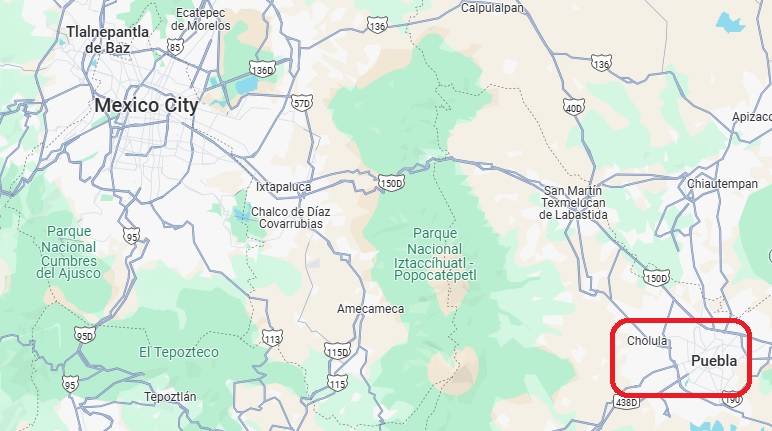
In the morning, Horacio picked us up and we drove to Cholula (cho-LOO-la), a suburb of the city of Puebla (PWEB-la), about two hour's drive southeast of the city. Here's a map:

After parking the car, we went for a bathroom break, and encountered something unusual - a toilet paper vending machine:
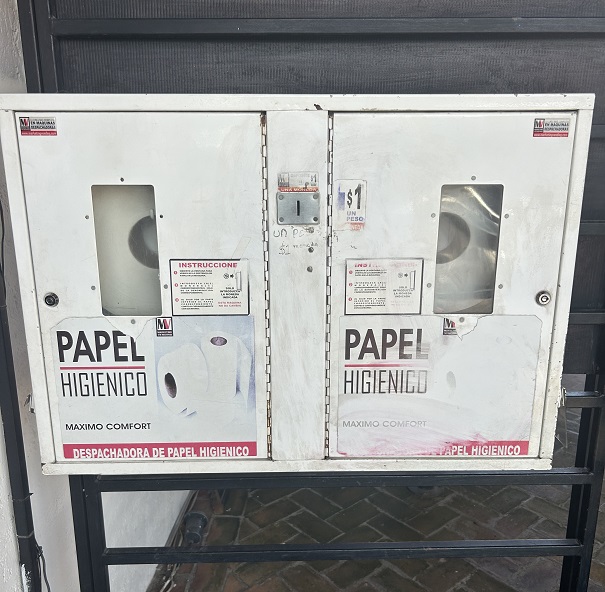
The machine has a coin slot, and two large rolls of toilet paper are visible behind windows. When a coin is inserted, one of the rolls turns, and the paper is dispensed from the bottom.
Put in a peso, and get half a dozen or so sheets of toilet paper. What will they think of next?
Before leaving the parking lot, we were accosted by a street vendor selling a variety of goodies, including something called chapulines (chap-oo-LEE-nehs) (w). What are chapulines, you ask? Do you really want to know? Okay, but you may be sorry you asked.
They're grasshoppers. Toasted and seasoned grasshoppers. Apparently a popular snack in some parts of Mexico. Esmond was brave enough to try some. He said they didn't have much of a taste in and of themselves; the seasoning has the taste. The bugs were just crunchy. I declined to try them - I'm an adventurous eater, but I draw the line at bugs. We bought some peanuts, which the vendor scooped out of a large bucket into a small plastic bag (I should have taken a picture).
We then walked across the street and up the block to the Great Pyramid of Cholula (w) (the ancient Mexicans built a lot of pyramids). Unlike the pyramids at Teotihuacan, most of this one is still underground - it looks like a vaguely pyramid-shaped hill. And it has a church built on top of it - the Spanish conquerors had a habit of building churches on top of "pagan" temples.
As we walked up the path that wound around the hill, I took these pictures of the archaeological dig taking place next to the pyramid, where they're uncovering more of the temple complex:
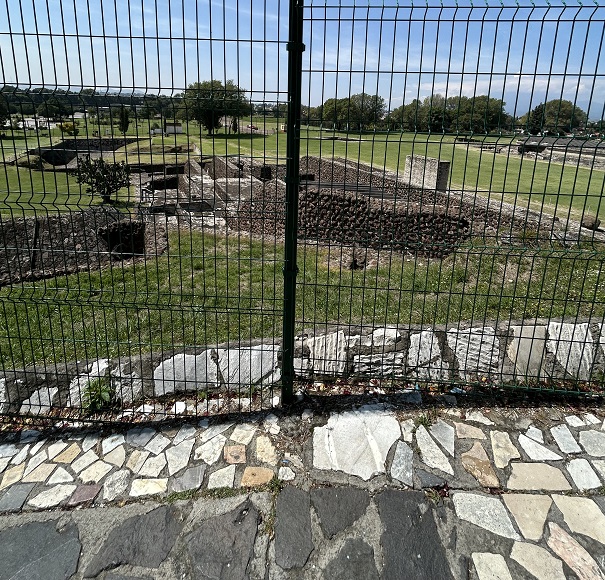
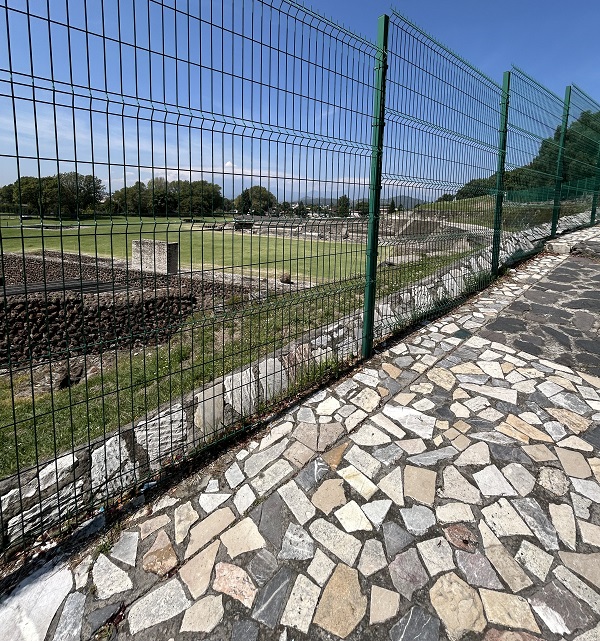
In both pictures, the stone path we were walking on can be seen in the foreground. Through a wire fence can be seen a large grassy area, where several structures are being excavated.
...and this panoramic shot of Cholula, taken from a spot near the top:
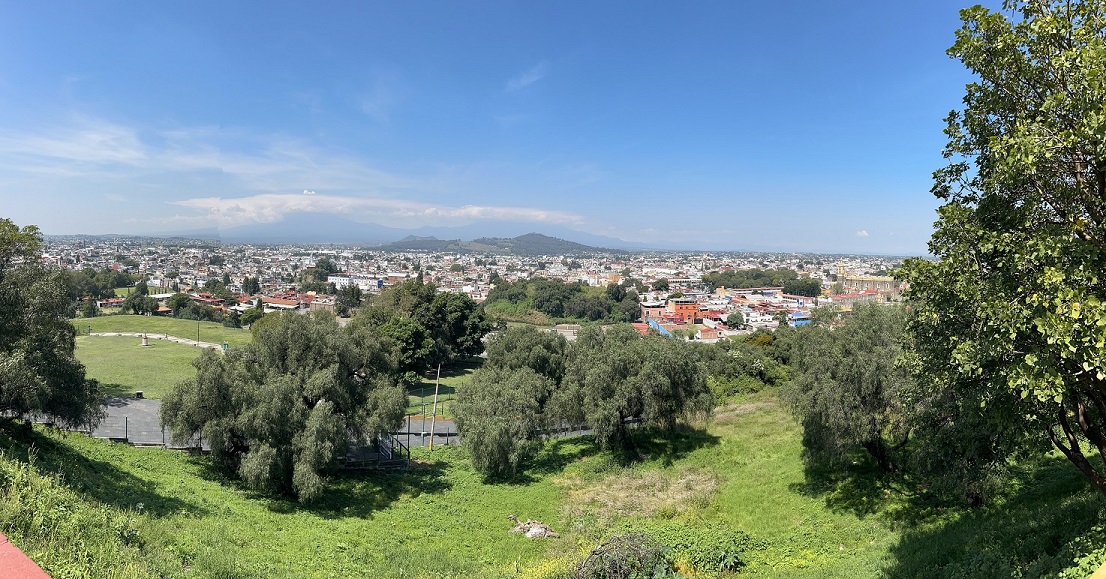
...and then I turned around and took a picture of the steps leading up to the church:
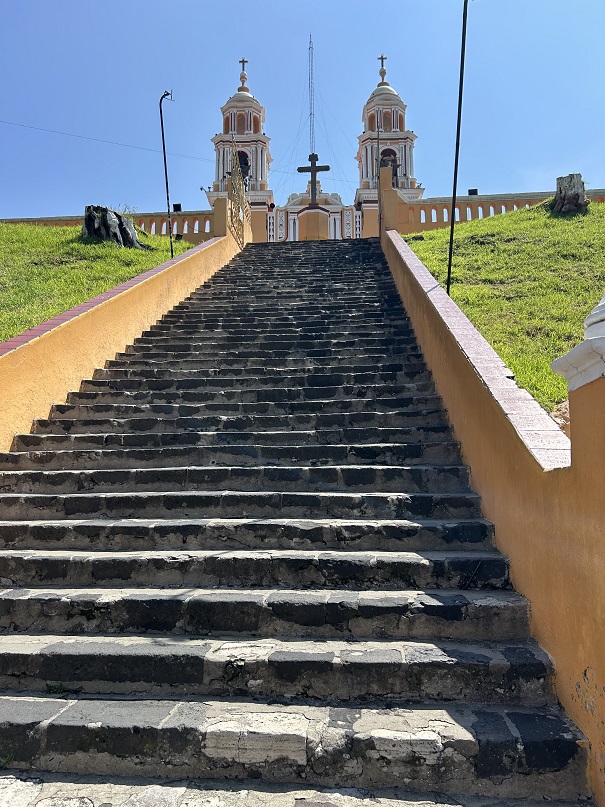
The stairway is long and steep, with walls on either side painted a bright orange. The two spires of the church are visible at the top of the stairs.
...and then we climbed the steps, and there was the church, the Santuario de la Virgen de los Remedios (Sanctuary of the Virgin of Remedies):
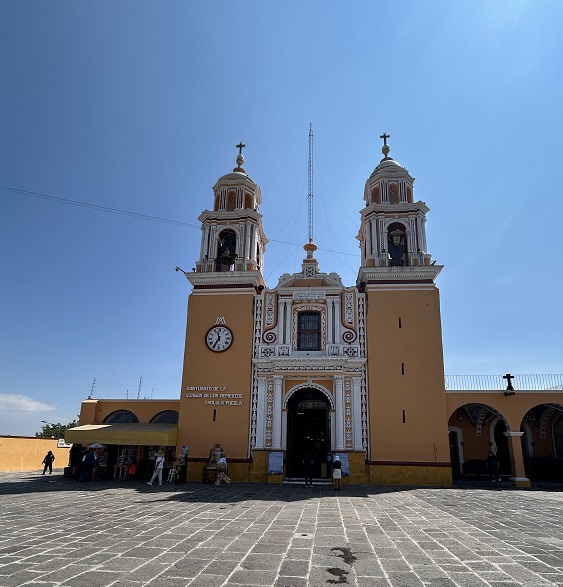
The church is painted the same orange color. A large clock face is mounted on the wall beneath one of the spires, and the name of the church is displayed below the clock. The church entrance is ornately decorated.
The church is extremely ornate inside, with nearly everything covered in gold leaf:
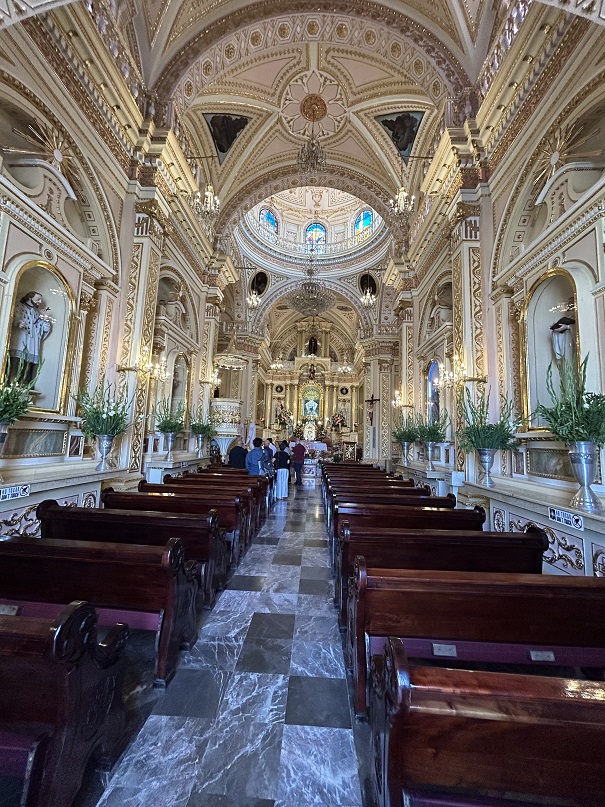
The main aisle, looking toward the altar. The floor is paved with what appears to be marble, in shades of white, gray and black. Niches on the sides hold statues of saints. Green plants in silver vases line both sides of the aisle.
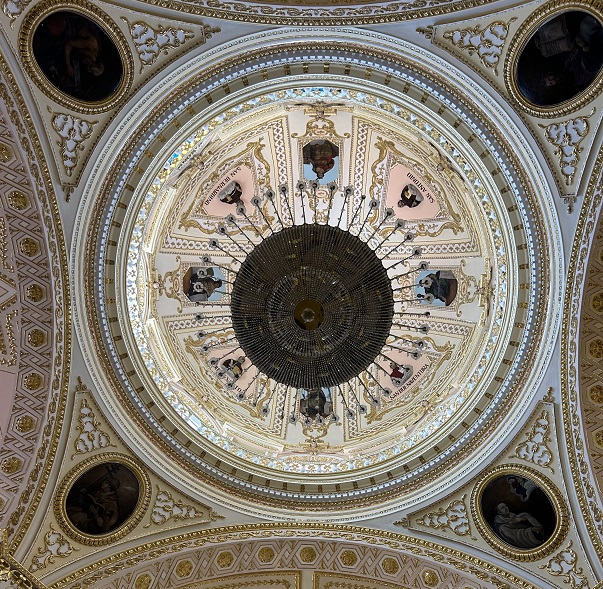
The dome above the altar. A large chandelier hangs from the underside of the dome, which is painted with images of various saints.
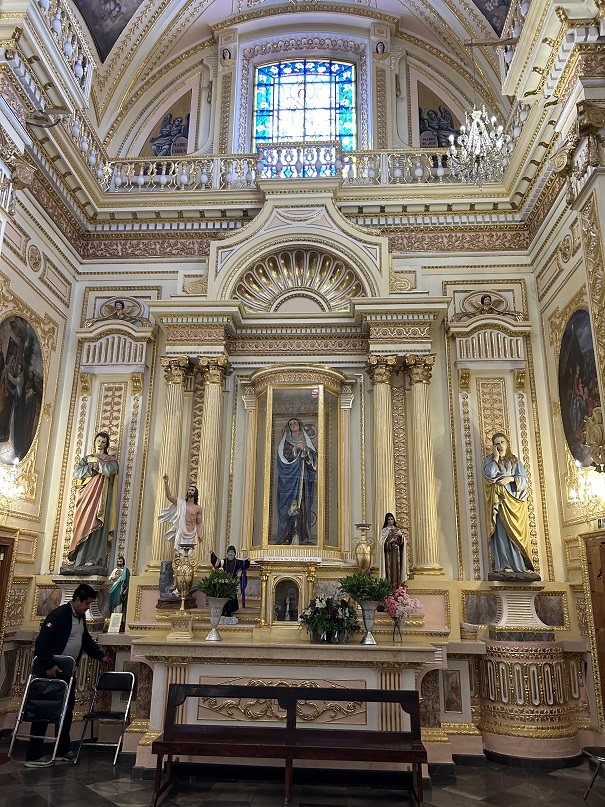
One of the two transepts, alcoves to the left and right of the altar. There is a staue of the Virgin, and more statues of saints, as well as more plants in vases. There is a kneeling bench for those who want to pray, and a blue and white stained glass window at the top.
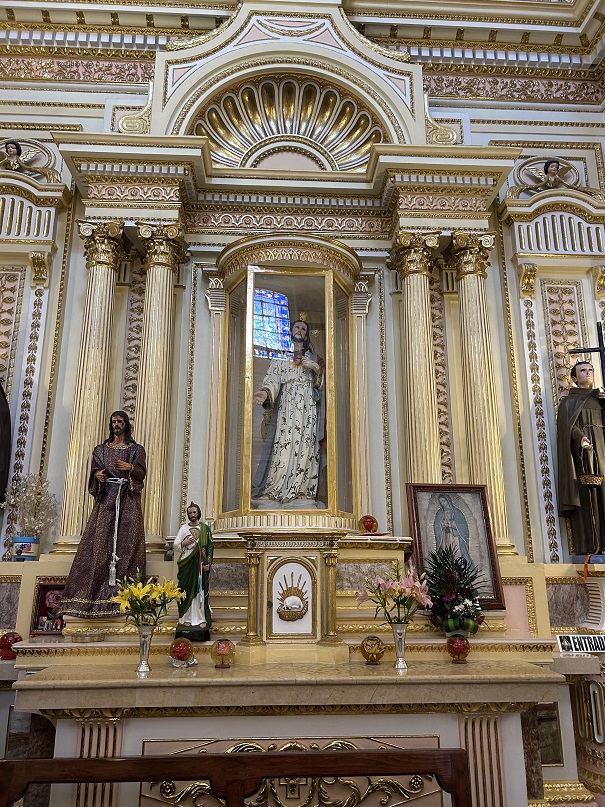
The other transept. The decor is similar, but with a statue of Jesus in place of the Virgin.
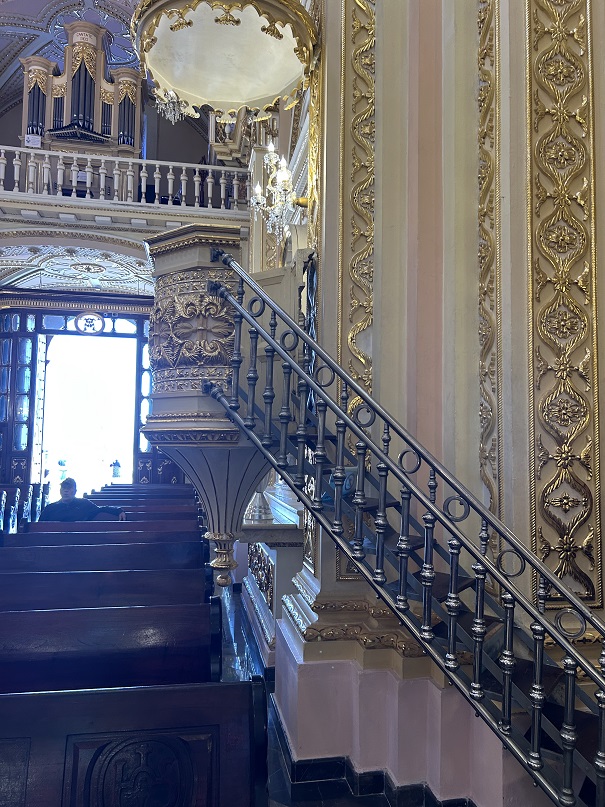
The pulpit is mounted high up on one side of the altar, with a long flight of stairs leading up to it.
In front of the altar, there is this image of the Virgin of Remedies, the patron saint of the city of Cholula.
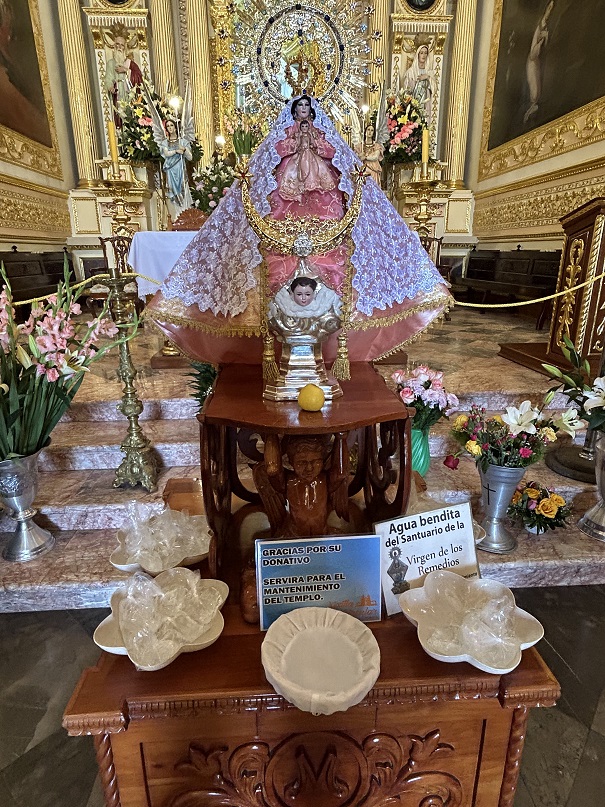
She's dressed in an elaborate pink and white dress, standing on a carved wooden plaform.
Notice the small dishes sitting on the table beneath the Virgin. Those clear plastic things in the dishes are bags of agua bendita (holy water). The blue sign says "Thank you for your donation. It will be used for the maintenance of the temple."
We walked around the side of the altar and came to a small side room with this mural on the wall:
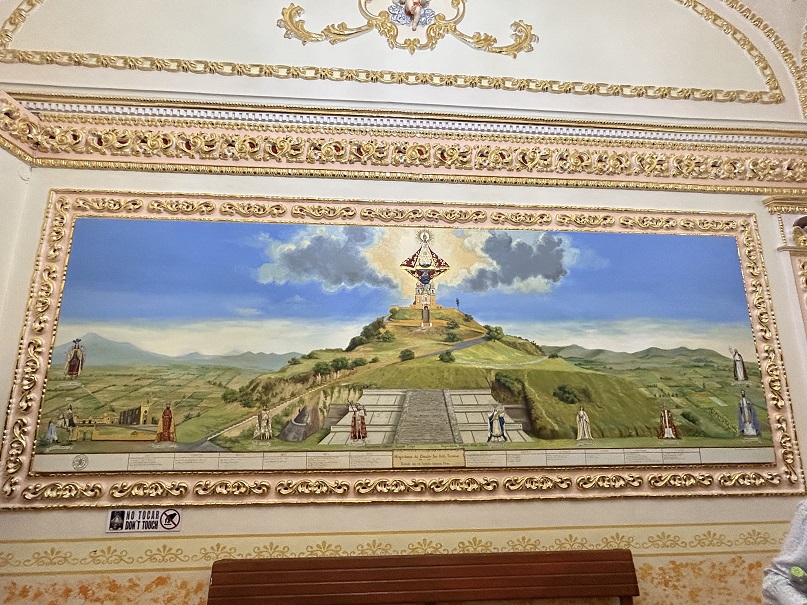
The mural shows the church sitting on top of the grass covered hill, surrounded by farmlands and with mountains in the distance. Along the bottom of the mural are images of several saints.
...and a carved wooden door, whose panels were decorated with symbols of various saints:
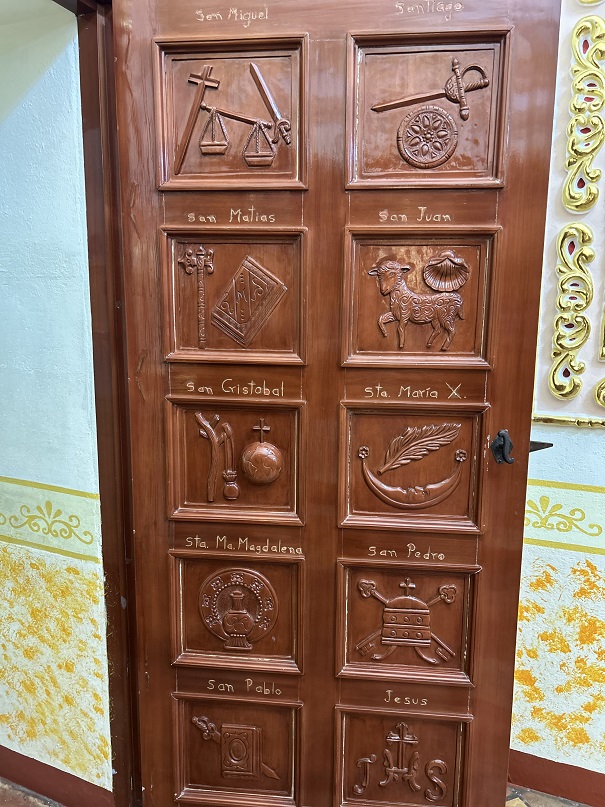
A corridor led us around to a small chapel behind the altar, with just a few seats. It appeared to be a place for private prayer. The sign at the bottom right says "The Virgin has an open heart for everyone. Please be brief in your request."
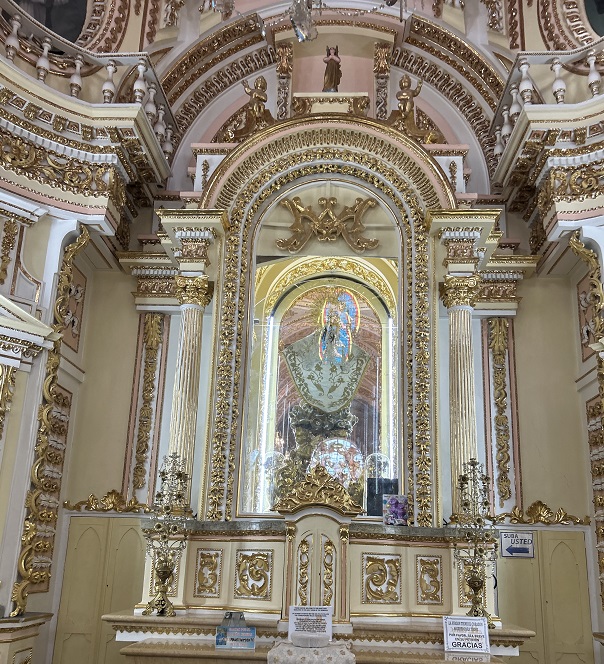
The chapel is as elaborately decorated as the rest of the cathedral.
We left the church and drove around for a while, looking for an Italian restaurant - according to Horacio, there are a number of them in the area. As we drove, I noticed a number of streets decorated with colorful archways, like this one:
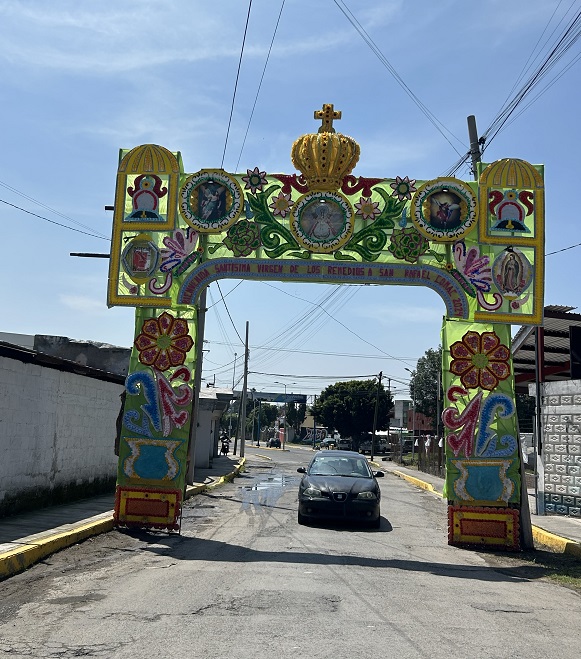
The arch spans the street. It's made of some kind of light green translucent material that allows light to shine through. It's decorated with images of flowers and butterflies, and has an elaborate gold crown at the top. Underneath the crown is written "Bienvenida Santisima Virgen de los Remedios a San Rafael Comac 2024" (Welcome to the Most Holy Virgin of the Remedies in San Rafael Comac). I didn't notice the inscription until I was writing this text; San Rafael Comac is the name of a neighborhood on the outskirts of Cholula.
We eventually found what appeared to be an Italian restaurant. Unfortunately, it turned out to be a Mexican restaurant with an Italian name. I suggested that we leave and try somewhere else, but we ended up staying put. Then as we were leaving, we saw another Italian restaurant right across the street. Another of life's little misadventures.
Next, we drove into downtown Puebla, and once again went to the Zócalo. This one is smaller than the one in Mexico City, but it has this ornate fountain in the center, the Fuente De San Miguel Arcangel (Fountain of St. Michael the Archangel):
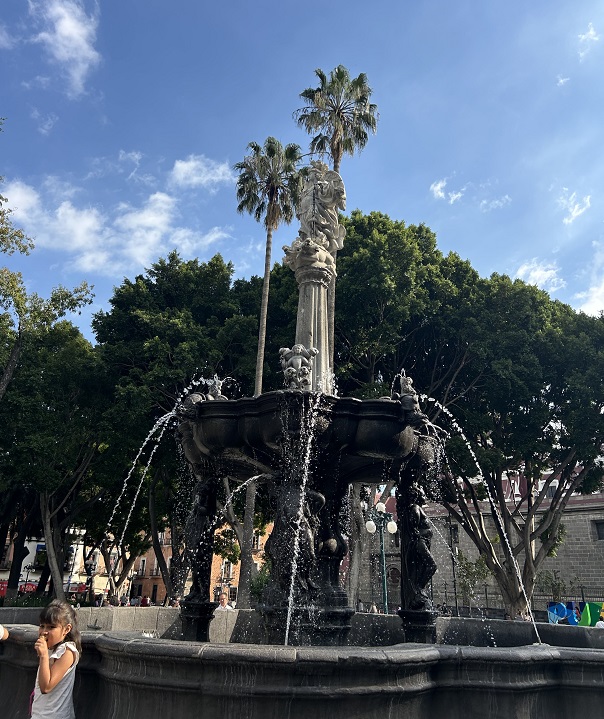
Four carved figures support a large bowl-shaped structure. Jets of water spray from the bowl into the basin below. A column ascends from the bowl, topped by the figure of an angel.
There was also this interesting sculpture called Arbol de la Vida (Tree of Life):
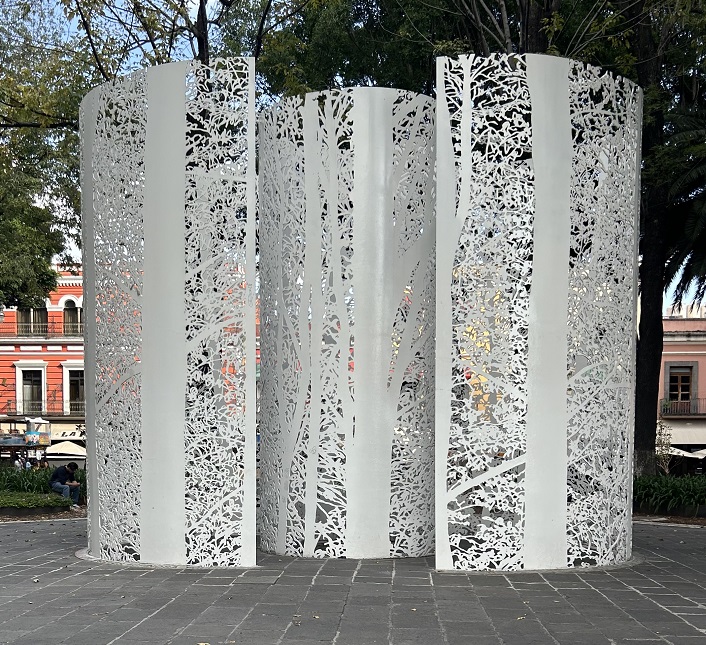
Tall vertical curved sheets of metal painted white, intricately carved with images of leaves and branches.
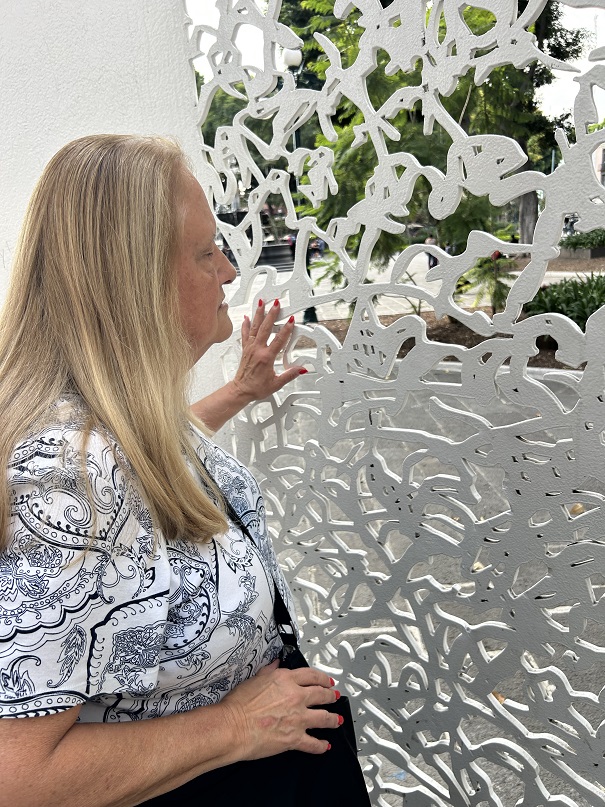
Terry examines a section of the sculpture.
And of course, there was a cathedral, the Catedral de Nuestra Señora de la Purísima Concepción (Cathedral of Our Lady of the Immaculate Conception):

The cathedral is made of gray stone, with two tall bell towers.
...which was as ornate as the one in Cholula, though not as glittery:
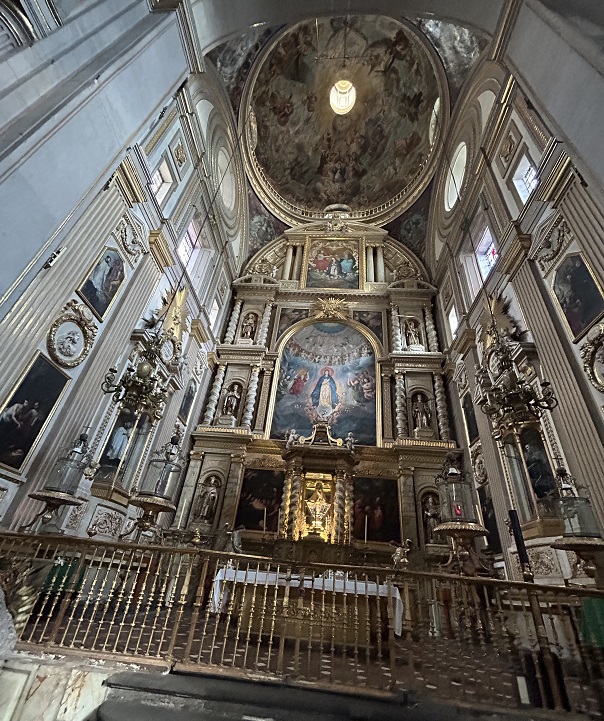
I was intrigued by this sculpture, and several others like it, at various places around the church. Were they supposed to represent martyrs who were burned for their beliefs? I did a little Internet research, and discovered that they represent souls suffering in purgatory.
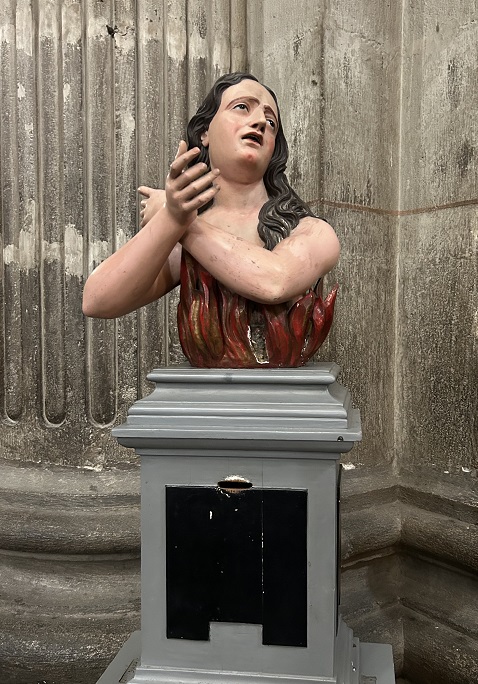
The head and shoulders of a man, surrounded by flames, with a very unhappy look on his face.
After leaving the church, we wandered around the downtown shopping district for a while. I was rather bemused by this clothing store:
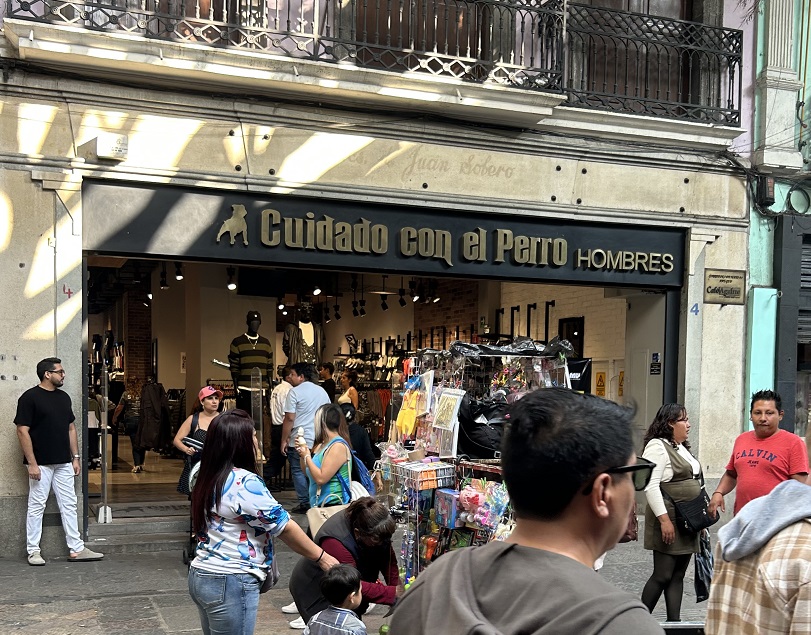
The name of the store is "Cuidado con el Perro."
There were actually three of these stores, one for men, one for women, and one for children. But I had to wonder - why would you name a clothing store "Beware of the Dog?"
This store also had me wondering...
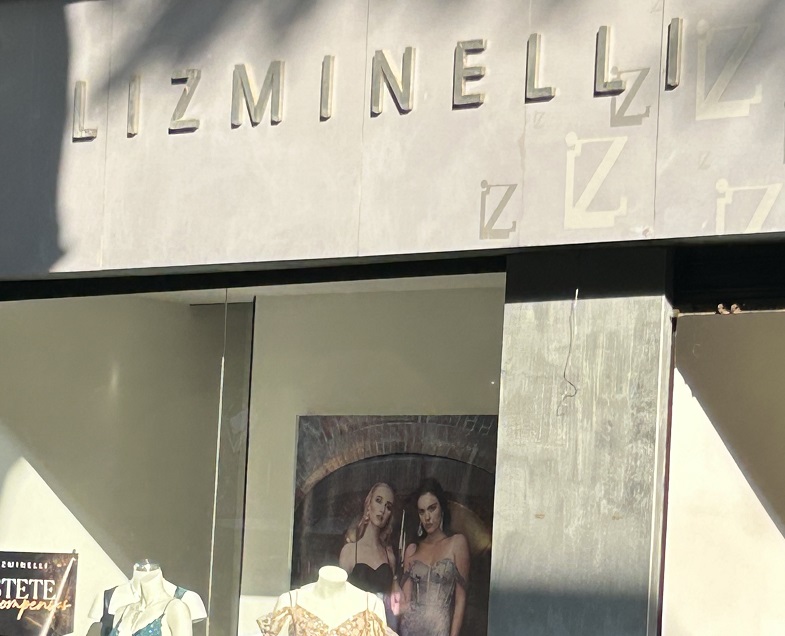
The name of the store is "Lizminelli" - all one word.
I wondered, "Does Liza know about this?"
We eventually found ourselves on a street called Calle de Dulces (Street of Candy). Sure enough, there were candy stores all up and down the street. I stopped into one store and bought a few items, and Terry and Lucia and Esmond stopped into a different store and bought a few more. I didn't get a picture of the street, because it had started raining, but I found this picture on the Internet:
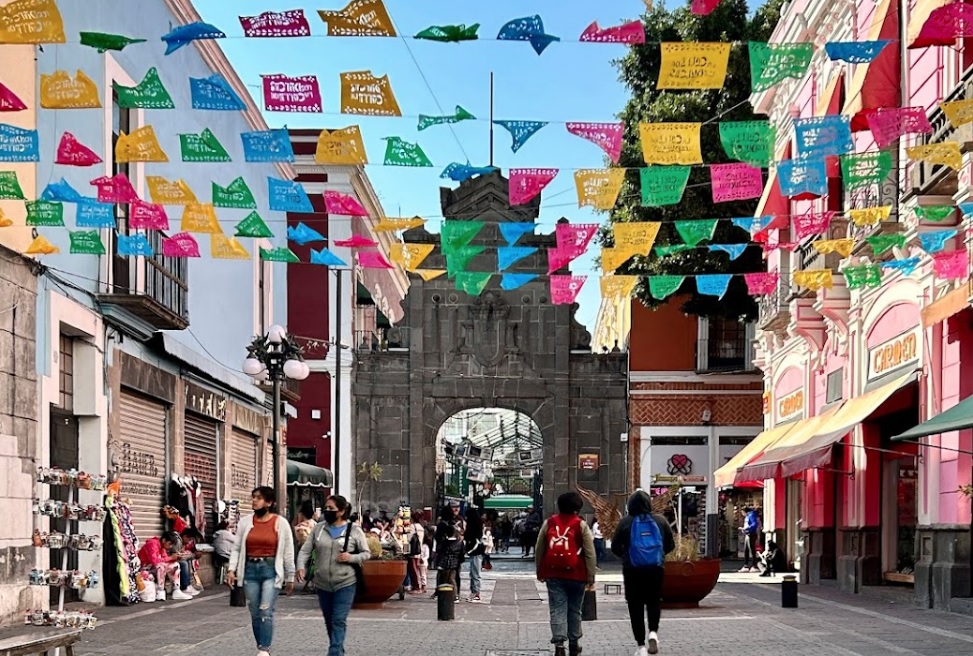
The street is for pedestrians only; a large stone archway at one end prevents cars from entering. Stores line both sides of the street, and colorful paper banners are strung across above the people walking below.